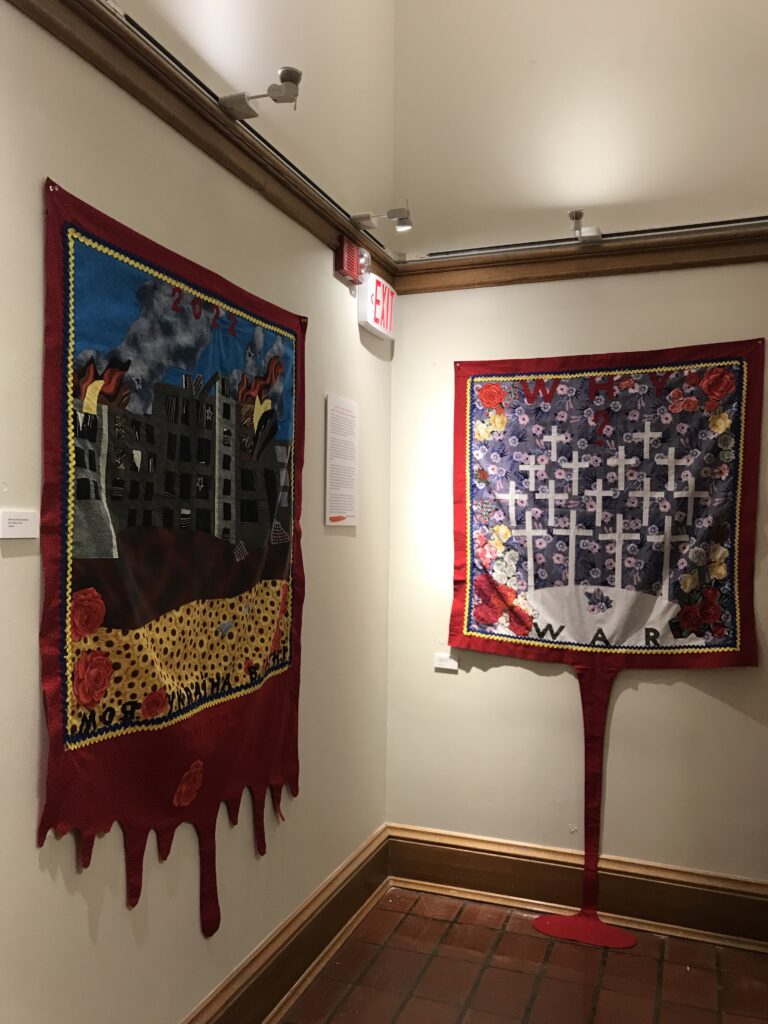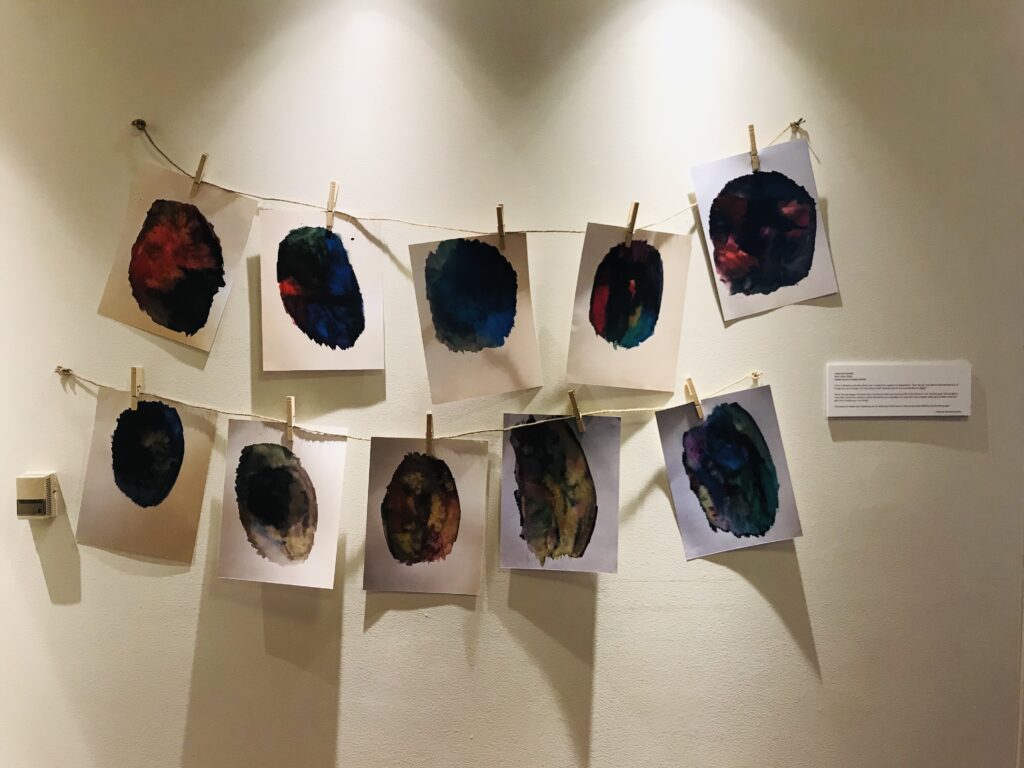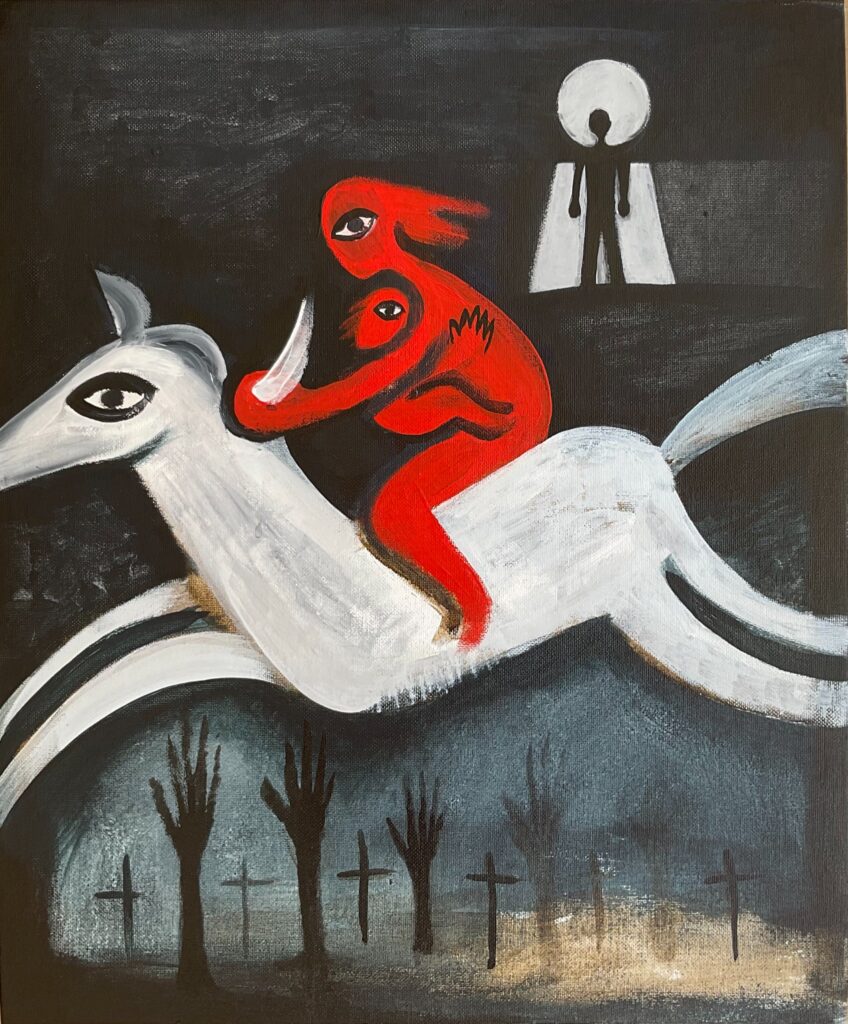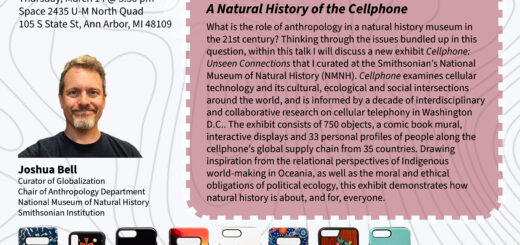Grace Mahoney – “Curating ‘Crisis’: My Experience Creating an Exhibit in Response to the War in Ukraine
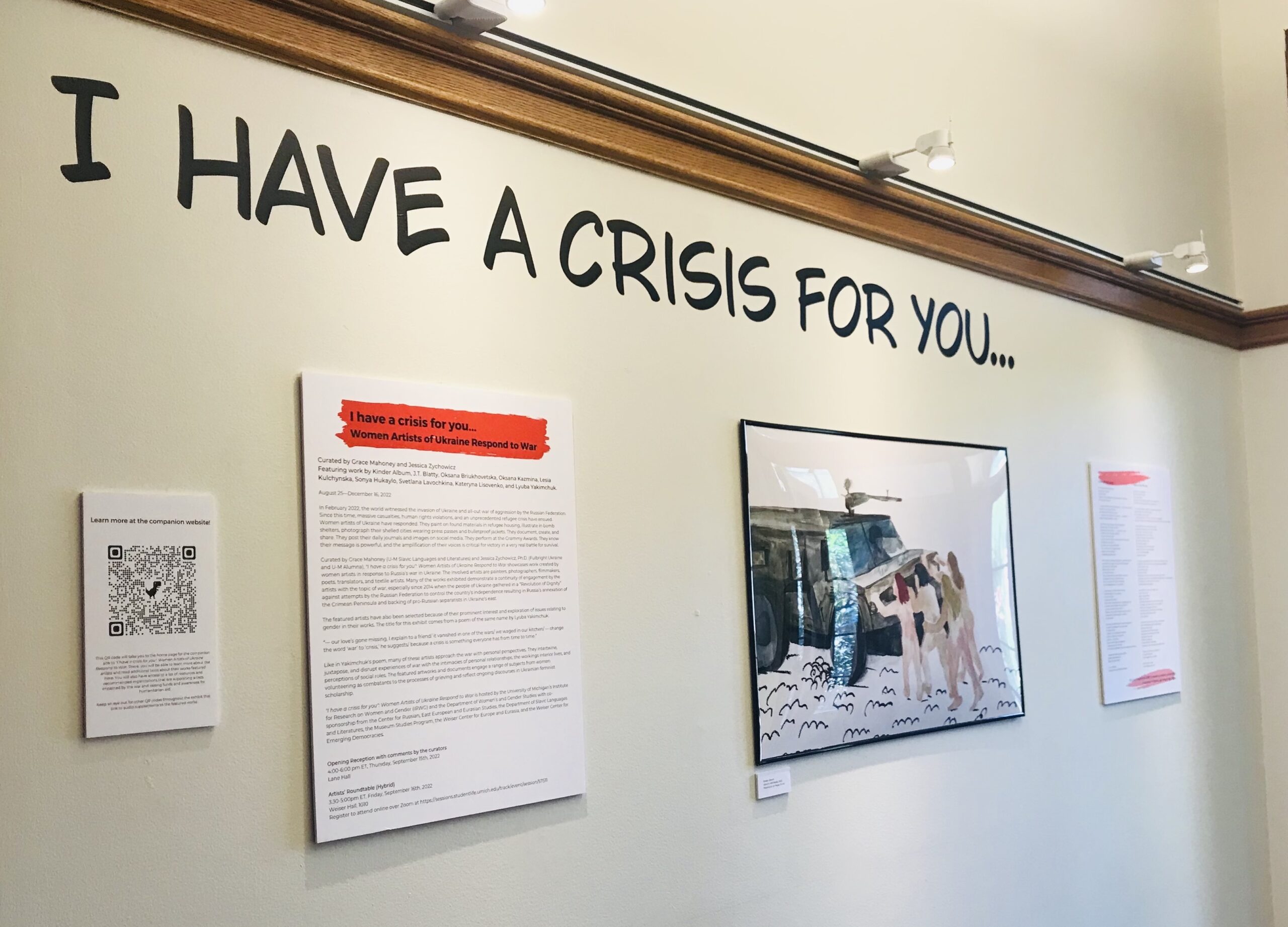
Around the same time I was hired by UM’s Institute for Research on Women and Gender (IRWG) as the Graduate Fellow for Exhibits, Russia launched a full-scale invasion of Ukraine. Ukraine is an important place to me. I spent a year there in 2014-15 as a student Fulbright researcher before beginning graduate school. Since then, I’ve visited several times and spent another year and a half there in 2019-20 conducting my MSP practicum and dissertation research. I have people there who are like family. I’ve cherished many vivid experiences traveling from cities lining the Black Sea to villages in the Carpathian mountains. And, of course, I ducked into every museum I could find. The all-out war unfolding in this land threw me into a personal crisis, and my new supervisors at IRWG gave me a gift—the chance to respond by making an exhibition for display at Lane Hall. The result is the exhibition titled “I have a crisis for you”: Women Artists of Ukraine Respond to War, which features visual art, textiles, and poetry by nine exceptional women.
A few key aims shared between my co-curator, Dr. Jessica Zychowicz, and myself drove our process in creating this exhibit. The first and simplest was to give feminist artists a platform to share their works and experiences, especially those made in response to the escalation of the war in February. The second was to showcase how these artists have been engaging this topic since 2014 when the war first began as a consequence of the Euro-Maidan Revolution (also known as the Revolution of Dignity). Resistance and reform are familiar methods for women’s and gender rights activists. This work weaves with the historic instances of popular revolution and re-imaginations of civic identity that have shaped the country in the decades of Ukraine’s independence.
Once we had a general framework in mind, we reached out to our network of artists to see what they had been working on. Jes had excellent connections through her research on contemporary feminist art and activism and as Director of Fulbright Ukraine. I had contacts from my work editing a series of contemporary Ukrainian poetry in translation and from gathering names and insights from the many Zoom panels and presentations on Ukraine that swelled in the wake of the outbreak of war.
A short timeline to opening and practical concerns meant we would be printing copies from digital files, not soliciting original works. We received excellent support from multiple campus entities and dedicated the majority of co-sponsorship funds to providing the participating artists with honoraria. I found myself opting for large prints hung in budget poster frames. As this is a non-proprietary and educational exhibit, one benefit of using prints and poster frames is that we can easily travel this exhibit to other interested spaces for ongoing display. The content is rich and I made every effort to honor that by bolstering the frugal presentation of these materials in an aesthetically pleasing configuration.
I drew on the many intersecting and overlapping motifs of the work we curated to create thematic rhymes and poetic linkages between pieces as they were installed in the exhibit space. One of our artists, Oksana Briukhovetska, is an MFA student at Stamps School of Art and Design. Her original pieces, brightly colored “grief rugs” made in the style of Chilean Arpilleras, brought texture and additional artistic gravitas to the exhibition. I also decided to hang Lesia Kulchinska’s expressionist watercolor diary on a clothesline with pins as a way to break up the monotony of framed works and lend a sense of the accumulating daily tally of each “diary entry.”
In working on the design team for POLIN Museum of the History of Polish Jews, Barbara Kirshenblatt-Gimblet describes creating exhibits in layers of information that can be more deeply discoverable for the interested visitor. I followed this concept in designing this exhibit by keeping the artists’ pieces as the first layer and offering artist reflections and poetry as printed texts in the exhibit space. Also present are QR codes that link to further layers online in the form of a companion website that features artist biographies, a set of resources for learning about Ukraine and feminist movements in Ukraine, and links to charities and humanitarian aid drives to support those affected by the war. Two portraits of volunteer fighters in the exhibition are accompanied by their biographies and excerpted text from interviews the artist conducted. Those hang as text next to the portraits, but visitors can also hear these now-deceased individuals speak by following QR codes to audio files on Vimeo with the recorded interviews.
Located in a university building on campus, the Lane Hall exhibit space calls for an educational mission in its exhibitions. In addition to connecting with fall courses for tours and encouraging related assignments, I designed in-exhibition features to prompt questions and interpretive work by visitors. Inspired by the art guides attending specific works at the Detroit Institute of Art, I created an interpretation guide for the exhibition’s primary image, a painting by Kinder Album titled Ukraine Will Resist that depicts a mass of female figures pushing against an invading military vehicle.
In the guide, I point to the artist’s techniques and choice of subject matter to convey thematic and symbolic messages. Translating and featuring the artists’ own reflections on their work and experiences during the war brings additional insights to the exhibition in terms of the artistic process and speaks to the larger issues playing out in this war related to displacement, the destruction of land and people, and resistance.
Several of the featured artists in “I have a crisis for you” left Ukraine, some with their children, shortly after the onset of the invasion. Sonya Hukaylo’s diptych dramatically illustrates her symbolic flight with a parent and child escaping on a red horse and their safe arrival on new shores in Sweden. Lesia Kulchinska’s watercolor diary marks days in exile with the limited resources available to those seeking refuge. Kinder Album’s painting Evacuation portrays colorful figures crowding on a train platform. What could otherwise be an ordinary day commuting in a bustling metropolis is given away by the would-be evacuee dramatically foisting himself onto the train. A closer look yields worried faces and tearful goodbyes.
The artists in the exhibit are keenly aware of the destruction of place and people unfolding in this war. Bruikhovetska’s rugs depict burning buildings and earth dotted with white crosses. The fresh cemetery depicted in this rug looks across the long hallway in the exhibition space to Kinder Album’s The Grief, in which a female figure holds up a mourning wreath–her arms, bent at distorted angles, signal internal turmoil.
Oksana Kazmina’s series of photographs depict her performance piece to dig a grave for a loved one as quickly as possible, as if it were the only chance to bury them between shellings. Thinking of the destruction wrought in her home city of Mariupol, Kazmina’s stages her performance at a children’s playground in Syracuse, NY, where she currently studies, creating a harsh juxtaposition of realities.
As this war goes on, the Ukrainian land is filling with bodies. Kateryna Lysovenko’s work interprets these events through the aesthetics of classical mythology, as in a piece featuring centaurs standing in a trench titled, I do not want to live in a world that produces collective nameless graves. I am against it. She and others see the work they do now as creating a corpus of memory, but these works grow in the garden-turned-cemetery of their homeland.
Women in Ukraine have fought against Russia’s aggression. Artists have captured this resistance, both symbolically, as in the painting Ukraine Will Resist, and in documentary terms. As a U.S. Army veteran, J.T. Blatty’s work has brought her into the community of Ukraine’s military. Her works featured in the exhibition highlight both Ukrainian women who fight in the armed forces (a group 60,000 strong) and civilians who received self-defense and first-aid training in anticipation of the invasion. The story of Iryna Tsvila, a florist who joined to fight as a volunteer, and the images of women you would otherwise find in cafes or the marketplace learning to shoot guns and tie tourniquets highlight how ordinary lives are militarized under these circumstances. Resistance comes in many forms: making art and building an archive of this time pushes against regimes of forgetting and erasure. The determination to live, as declared by Kazmina’s diary poster Tonight I woke to air raid sirens. I decided to masturbate. flicks a middle finger at the Russian efforts to terrorize Ukraine’s residents in their hours of repose.
We titled this exhibit based on a poem by Lyuba Yakimchuk. In the poem, Yakimchuk satirically points out that “war”–its mind-bending unreality and heartbreaking cruelty–is often softened in discourse with words like “crisis” to make it easier for us to digest, more palatable to live with. On a personal scale, war might trigger a crisis, as it has done to me. This exhibit demonstrates how artists move between the personal, social, and political with uncompromising witness to their experiences of war. We are called to witness with them.
Grace Mahoney
Grace Mahoney is a PhD candidate in the Department of Slavic Languages and Literatures and the IRWG Graduate Fellow for Exhibits at the University of Michigan. Her dissertation explores the relationship between literature and literary memorial museums in the Soviet Union. Grace’s work as a curator is informed by her training in studio arts, art history, and museum studies (MSP ’16), as well as internship and volunteer experience at the Seattle Art Museum, the Ukrainian American Archives and Museum of Detroit, and the Mikhail Bulgakov Memorial Museum in Kyiv, where she completed a digitization project hosted by University of Michigan Library Digital Collections.
“I have a crisis for you”: Women Artists of Ukraine Respond to War will be on display in Lane Hall through December 15, 2022 and in the fifth-floor gallery in Weiser Hall January 3–February 23, 2023. The exhibit is generously co-sponsored by the Institute for Research on Women and Gender, the Department of Women’s and Gender Studies, the Museum Studies Program, the Department of Slavic Languages and Literatures, the Center for Russian, East European, and Eurasian Studies, the Weiser Center of Europe and Eurasia, and the Weiser Center for Emerging Democracies.

